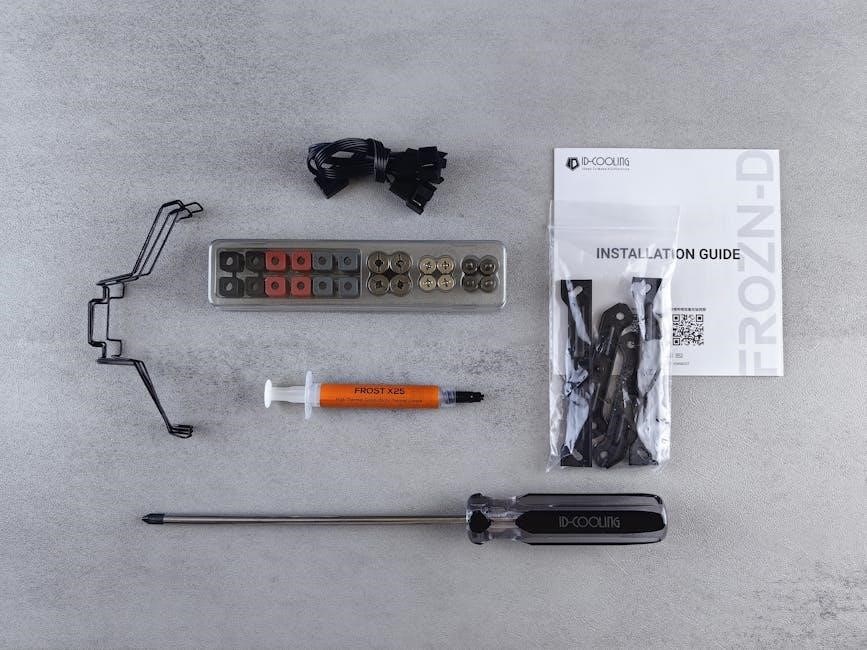The Denver Botanic Gardens presents Spirit Guides, a captivating exhibition featuring vibrant, handcrafted sculptures by Mexican artists Jacobo and María Ángeles. This unique display blends art, nature, and spirituality, offering visitors a chance to explore the intersection of culture and the environment; Located amid the gardens’ lush landscapes, Spirit Guides invites reflection and connection with the natural world, showcasing the artists’ imaginative hybrid creatures inspired by Oaxacan traditions. This exhibition is a must-see for art enthusiasts and nature lovers alike, running through September 8, 2024.
What Are Spirit Guides?

Spirit Guides are vibrant, handcrafted sculptures created by Mexican artists Jacobo and María Ángeles. These imaginary hybrid animals, inspired by the Zapotec calendar and Oaxacan traditions, blend elements of flora, fauna, and the mystical. The sculptures are designed to evoke a sense of wonder and connection to nature, while also reflecting the cultural heritage of their creators. Placed throughout the Denver Botanic Gardens, they serve as interactive and thought-provoking pieces, inviting visitors to explore the intersection of art, spirituality, and the natural world.
The Significance of Spirit Guides in the Context of Botanic Gardens
The Spirit Guides sculptures at Denver Botanic Gardens symbolize a harmonious blend of nature, art, and spirituality. These vibrant, handcrafted pieces, inspired by Oaxacan traditions, foster a deeper connection between visitors and the natural world. By integrating cultural and mystical elements, they enhance the gardens’ role as a space for reflection and inspiration. The exhibition not only celebrates Mexican cultural heritage but also aligns with the gardens’ mission to inspire appreciation for the interplay of art and nature, creating a unique and enriching visitor experience.
The Exhibition “Spirit Guides” at Denver Botanic Gardens
The “Spirit Guides” exhibition at Denver Botanic Gardens showcases vibrant sculptures by Mexican artists Jacobo and María Ángeles, blending art, nature, and spirituality in a unique outdoor display.
Overview of the Exhibition
The “Spirit Guides” exhibition at Denver Botanic Gardens, running from April 28 to September 8, 2024, features eight vibrant sculptures by Mexican artists Jacobo and María Ángeles. These handcrafted, hybrid creatures, inspired by the Zapotec calendar, blend flora, fauna, and mysticism, creating a joyful yet contemplative experience. Organized by the gardens, the exhibition is part of a traveling series, showcasing the artists’ unique vision. Located at the York Street location, it offers a harmonious mix of art, nature, and cultural heritage, free for members to explore and enjoy.
Key Features and Highlights of the Exhibition
The “Spirit Guides” exhibition showcases eight vibrant, large-scale sculptures by Jacobo and María Ángeles, inspired by the Zapotec calendar. These colorful, hybrid creatures blend mythology and nature, placed strategically throughout the gardens. The exhibition, running from April 28 to September 8, 2024, offers a unique blend of art and spirituality; As part of a traveling series, it highlights the artists’ imaginative vision. Visitors can explore these fantastical pieces, enhancing their connection with the gardens’ natural beauty and cultural richness, with guided tours available to deepen the experience.

The Role of Denver Botanic Gardens as a Cultural Venue
Denver Botanic Gardens serves as a 24-acre oasis blending nature, art, and culture. It hosts diverse exhibitions, concerts, and educational programs, enriching the community and fostering cultural engagement.
History and Mission of Denver Botanic Gardens
Founded in 1959, Denver Botanic Gardens is a 24-acre urban oasis dedicated to connecting people with plants and fostering environmental stewardship. Its mission emphasizes education, conservation, and community engagement through diverse plant collections and cultural programs. The gardens showcase a global array of flora, offering a tranquil escape in the heart of the city. By hosting exhibitions like Spirit Guides, Denver Botanic Gardens continues to blend art, nature, and culture, enriching the visitor experience and promoting cross-cultural understanding.
Previous Exhibitions and Cultural Events Hosted by the Gardens
Denver Botanic Gardens has a rich history of hosting diverse exhibitions and events that blend art, nature, and culture. Past exhibitions have featured works by international artists, such as Alexandra Kehayoglou, and immersive displays that celebrate global botanical heritage. The gardens are also known for their annual Summer Concert Series, which brings renowned musicians to perform amidst the lush landscapes. These events highlight the gardens’ commitment to fostering community engagement and cultural enrichment, making them a vibrant cultural hub in Denver.

The Artists Behind “Spirit Guides”

Jacobo and María Ángeles, renowned Mexican artists from Oaxaca, are celebrated for their vibrant, handcrafted sculptures inspired by indigenous traditions and natural symbolism. Their artistic vision combines cultural heritage with contemporary creativity, creating captivating pieces that reflect their deep connection to their roots and the environment. Their workshop is known for producing unique, imaginative designs that bridge the spiritual and the physical world, making their contributions to Spirit Guides a testament to their artistic excellence;
Jacobo and María Ángeles: Their Background and Artistic Vision

Jacobo and María Ángeles are esteemed Mexican artists from Oaxaca, known for their vibrant, handcrafted sculptures inspired by Zapotec traditions and natural symbolism. Their workshop produces intricate, imaginative pieces that reflect a deep connection to their cultural heritage. Drawing from indigenous myths and the natural world, their artistic vision blends traditional techniques with contemporary creativity, resulting in unique, hybrid creatures that captivate audiences. Their work in Spirit Guides showcases this fusion, bringing together the mystical and the physical through art that resonates with both cultural and environmental themes.
The Inspiration Behind the Spirit Guides Sculptures
The Spirit Guides sculptures draw inspiration from Zapotec cultural traditions and the natural world, blending indigenous myths with vibrant, handcrafted designs. Jacobo and María Ángeles crafted these pieces to symbolize a connection between the physical and spiritual realms, reflecting their deep respect for Oaxacan heritage; The sculptures’ intricate details and bold colors evoke mystical creatures, bridging the gap between flora, fauna, and the divine. This artistic vision creates a sense of wonder, inviting viewers to contemplate the harmony of art, nature, and spirituality in the gardens’ serene setting.

Special Events and Activities Related to Spirit Guides
The exhibition offers guided tours and interactive experiences, allowing visitors to deepen their understanding of the sculptures and their cultural significance. Workshops and educational programs are also available.

Guided Tours and Interactive Experiences
Visitors can explore the Spirit Guides exhibition through docent-led tours, offering insights into the sculptures’ cultural significance and artistic craftsmanship. Interactive experiences, such as touchable sculptures and digital displays, engage guests of all ages. These activities foster a deeper connection to the art and the gardens’ natural beauty, creating a memorable and enriching experience for everyone. The tours and interactive elements are designed to inspire curiosity and appreciation for the fusion of nature, art, and spirituality at Denver Botanic Gardens.
Workshops and Educational Programs for Visitors
The Denver Botanic Gardens offers engaging workshops and educational programs tied to the Spirit Guides exhibition, allowing visitors to delve deeper into its cultural and artistic significance. Hands-on activities inspired by Jacobo and María Ángeles’ techniques enable participants to craft their own sculptures or explore traditional Oaxacan art methods. Educational programs include lectures on the Zapotec calendar and family-friendly workshops, fostering a connection to Mexican heritage and artistic expression. These offerings enrich the exhibition experience, making it accessible and meaningful for visitors of all ages and backgrounds.

The Cultural and Spiritual Significance of the Exhibition
Spirit Guides embodies ancestral wisdom and mystical connections, reflecting Mexico’s rich cultural heritage. The vibrant sculptures inspire reflection and wonder, bridging spirituality with nature’s beauty at the gardens.

How Spirit Guides Reflect Mexican Cultural Heritage
The Spirit Guides exhibition at Denver Botanic Gardens showcases vibrant sculptures inspired by Mexico’s rich cultural traditions. Created by Jacobo and María Ángeles, these works draw from Oaxacan folklore, blending indigenous symbolism with contemporary art. The sculptures, often depicting hybrid creatures, reflect the Zapotec calendar and mystical beliefs, offering a glimpse into Mexico’s spiritual heritage. Their use of bold colors and intricate details highlights the artistic and cultural legacy of Oaxaca, making the exhibition a celebration of Mexican identity and creativity, while fostering cross-cultural appreciation and understanding.
The Intersection of Art, Nature, and Spirituality at the Gardens
The Spirit Guides exhibition seamlessly merges art, nature, and spirituality, creating a unique experience at Denver Botanic Gardens. Vibrant sculptures by Jacobo and María Ángeles, inspired by Oaxacan traditions, are nestled among lush flora, inviting visitors to explore the mystical connection between natural and spiritual worlds. The sculptures’ fantastical creatures, blending fauna and mysticism, evoke contemplation and wonder. This integration of art and nature highlights the gardens’ role as a space where creativity, culture, and the environment converge, fostering a deeper appreciation for the spiritual dimensions of the natural world.
Visitor Experience and Feedback
Visitors find the Spirit Guides exhibition enchanting, with its vibrant sculptures blending seamlessly into the gardens, creating a magical and thought-provoking experience for all.
What Visitors Are Saying About the Exhibition
Visitors describe the Spirit Guides exhibition as enchanting and thought-provoking, praising the vibrant sculptures that seamlessly blend into the gardens’ natural beauty. Many appreciate how the artwork inspires reflection and wonder, while others highlight the unique cultural insights into Oaxacan traditions. Families and art enthusiasts alike find the exhibition engaging, with some noting the joy of discovering the intricate details of the sculptures. The exhibition has become a memorable experience, enhancing the gardens’ charm and leaving a lasting impression on all who visit.
How the Exhibition Enhances the Botanic Gardens Experience
The Spirit Guides exhibition enriches the Denver Botanic Gardens by blending art, nature, and spirituality, offering visitors a unique cultural experience. The vibrant sculptures by Jacobo and María Ángeles create an interactive and thought-provoking journey, drawing visitors deeper into the gardens. This fusion of art and nature attracts diverse audiences, fostering a sense of community and inspiration. The exhibition not only highlights the gardens’ commitment to showcasing global artistic traditions but also enhances their role as a cultural and educational destination, making each visit more engaging and memorable.
The “Spirit Guides” exhibition at Denver Botanic Gardens successfully blends art and nature, enhancing its cultural impact. Future exhibitions promise to continue this legacy, engaging audiences with innovative displays and fostering a deeper connection between art, nature, and community.
The Impact of Spirit Guides on Denver Botanic Gardens
The “Spirit Guides” exhibition has significantly enhanced Denver Botanic Gardens’ reputation as a cultural hub. By showcasing vibrant sculptures by Jacobo and María Ángeles, it has attracted diverse audiences, fostering a deeper appreciation for art and nature. The exhibition’s success highlights the Gardens’ commitment to innovative programming, solidifying its role as a premier destination for both botanical and artistic experiences. This impact ensures continued growth in visitor engagement and cultural influence.
Future Exhibitions and Events at the Gardens
Denver Botanic Gardens continues to evolve as a cultural hub, promising exciting future exhibitions and events. The Summer Concert Series remains a highlight, bringing renowned artists to the lush surroundings. Beyond music, the Gardens plans to host diverse events, including art installations, workshops, and seasonal festivals. With a focus on education and community engagement, upcoming programs will explore themes of sustainability and creativity. Stay tuned for innovative displays that blend nature, art, and culture, ensuring the Gardens remain a vibrant destination for all.































































